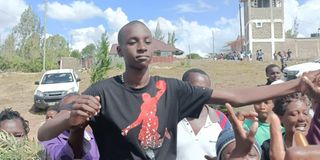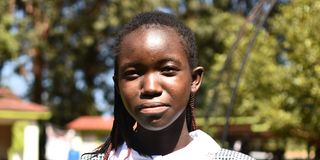Premium
Here are the top 2021 KCPE candidates nationally

Magata Bruce Makenzie from Gilgil Hill Academy in Nakuru County is the top candidate in the 2021 Kenya Certificate of Primary Education (KCPE) exam after scoring 428 marks out of 500 marks. He hopes to join Alliance High school.
Magata Bruce Makenzie from Gilgil Hill Academy in Nakuru County is the top candidate in the 2021 Kenya Certificate of Primary Education (KCPE) exam after scoring 428 marks out of 500 marks.
The top mark is a drop from the 2020 KCPE examination highest score of 433.
The second candidate is Momanyi Ashley Kerubo with 427 from Maikini School Kibos, followed by six candidates who scored 426 marks.
They are Kuoma Charity of Holy Family Misikhu girls, Mbugua Sharon Wairimu of Emmanuel Academy, Mueti Shantel Ndinda of Kitengela International schools, Stanley Otieno Omondi of Rophine Field Junior School, Wekesa Naomi Neema of White Star Academy and Kimani Ethan Karuga of Stepping Stones Preparatory.

Stanley Otieno Omondi of Rophine field Junior School Utawala.
Other top candidates nationally include, Njeru Joel Junior Musyoka of Nyangwa Primary (425), Kiriinya Muriuki Victor PCEA Mwimbi Boarding (425), Diana Rose Matolo of Fesbeth Academy (425), Kaberia Emmanuel Munene of New Bambini (425), Emmanuel Kiplangat Ng’etich of Moi Kabarak (425) and George Morris Otieno of Hill School (425).
From the special needs schools, Bethany Tahillah Migosi from Thorn Grove Academy is the top candidate with 417 marks, compared with the top candidate who scored 420 marks in 2020, followed by Grace Neema Katana of Havilah Academy Mtwapa Primary School with 407.
Scored 401 marks
The third was Kamau Jackson Ndegwa of Muthiria primary school with 401 marks, Musyoka Kings Kevin of Kathonzweni AIC with 401 marks and Migosi Dominic Sese of Mau Narok Primary who also scored 401 marks.
Other top 10 candidates in the special schools are Otieno Barack Onyango of St Cecilia Olare (399), Mwachofi Elnora Mkawaindi of De Paul Catholic School Kamulu (397), Philip Karani of Likoni School for the Blind (397) and Dorcas Cherono of St Sofia Kapchepob Keny Primary (396).

Kiriinya Muriuki Victor.
While announcing the results, Education Cabinet Secretary George Magoha said although the highest mark dropped from 433 in 2020 to 428 in 2021, the mean average performance and quality of grades for all candidates was higher this year.
“Whereas 8,091 (0.68 percent) candidates scored between 400 and 500 marks in the 2020 KCPE, the number increased to 11,857 (0.97percent) in the 2021 KCPE,” said the CS.
In 2019, a total of 9,673 scored between 400 and 500 marks.
A total of 315,275 have scored between 300 and 399 marks compared to 282,090 in 2020 and 242,821 in 2019.
Those who have scored between 200 and 299 marks are 578,197 compared to 589,027 candidates in 2020 and 566,069 candidates in 2019.
In the 2021 KCPE more pupils scored less than 99 marks (1,170 candidates) compared to the 307 candidates who scored similar marks in 2020. In 2019, there were 1,393 candidates who stored between 0 and 99 marks.
Transition policy
“Regardless of the mark the student has scored, all candidates who sat the examination will be slotted to join Form One under the 100 percent transition policy from primary to secondary schools,” said Prof Magoha.

Diana Rose Matolo of Fesbeth Academy, Kakamega.
The number of candidates with special needs was lower in the year 2021 (2,483) compared to that of 2020 (2,675).
“The categories with the highest number of candidates with special needs in the 2021 KCPE examination were those with physical disabilities (1,013), followed by those with hearing impairment (734),” said the CS.
For the SNE schools, a total of four candidates scored between 400 marks and 500 compared to the nine who scored similar mark in 2020 and 11 in 2019.
A total of 337 scored between 300 and 399 marks compared to 318 in 2020 and 211 in 2019, while a total of 778 candidates scored between 200 and 299 marks in the 2021 KCPE exams compared to 897 candidates in 2020 and 726 in 2019.
Those who scored between 100 marks and 199 marks were 1,302 candidates compared to 1,356 in 2020 and 1,350 in 2019 while a total of 29 candidates scored between 0 and 99 marks compared to 11 in 2020 and 45 in 2019.





